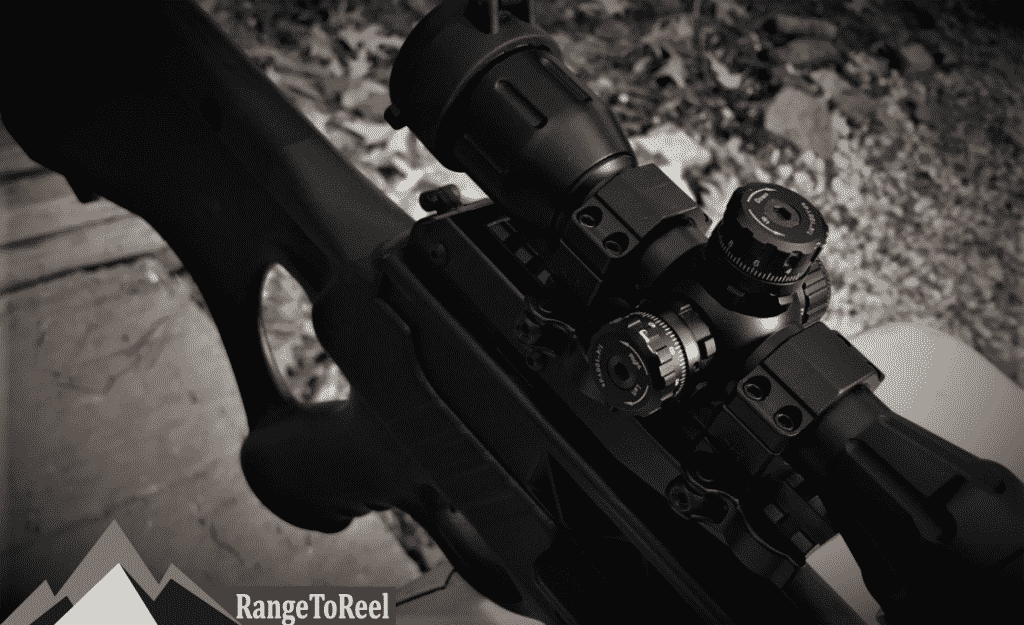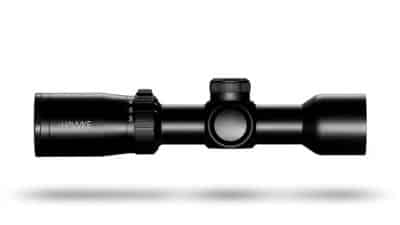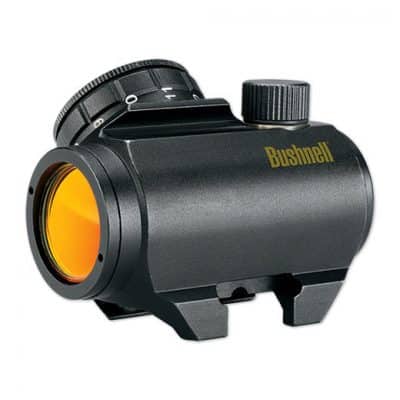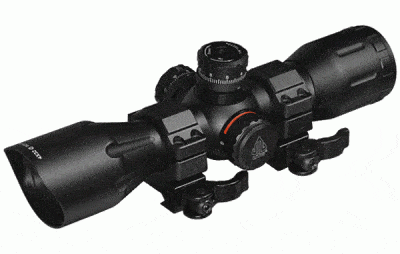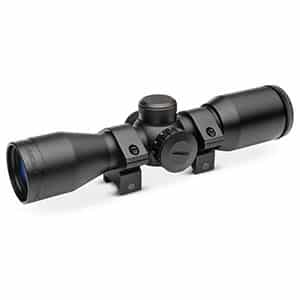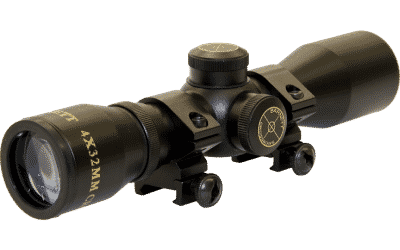It really is amazing how little actual information there is about mounting optics onto your crossbow. Seems like everybody has an opinion on the best rife scope, but nobody wants to broach the crossbow topic. Anybody who wants to excel at crossbow hunting really needs to pair their bow with the right scope. Like rifle scopes crossbow scopes have many of the same defining characteristics. You’ll have to choose between eye relief, aperture size and different reticles. The only major difference is that the scope will have to withstand cross directional force caused by the forward thrust of the arrow. Rather than the traditional rear trajectory recoil found in a traditional rifle. Our guide will take you through all of these different characteristics and help you find the best crossbow scope.
What’s The Best Crossbow Scope?
1. Nikon Bolt XR Crossbow Scope
Check Price: Cabelas
Nikon’s Bolt XR Crossbow scope is one of the most popular crossbow scopes on the market. Nikon has long been a force in the optic industry. By offering some of the clearest sight pictures on the market there’s no surprise the Bolt XR is so popular. With it’s affordable price tag, clear sight picture and sturdy design this scope is well worth a look.
Nikon designed its Bolt XR scope specifically for the crossbow platform. Using a compact and lightweight design this scope will be the perfect size for any bow. Featuring a fixed 3x magnification, you’ll have the range to see clearly on your next hunt. The range estimating reticle is designed to be zeroed at 20 yards and will extend your functional range out past 60. By using a larger 32mm lens Nikon was able to increase the brightness without much difference in size. The clear and bright sight picture is further enhanced with Nikons fully multicoated lens. Allowing up to 92% light transmission you’ll have a clear sight picture from dawn til dusk.
I really love the zero-reset turrets that Nikon included with this sight. Zero-reset turrets allow you to sight in at 20 yards and quickly change your zero. Simply lift the spring loaded adjustment knob and rotate your zero. Field adjustments are now as simple as dialing in your range. When you’re in the field you won’t have to worry about damaging this scope. The scope is completely waterproof, fogproof and shockproof. Further backed by Nikon’s no-fault lifetime repair or replacement policy. Unless you went out of your way to destroy the scope Nikon will send you a replacement.
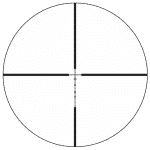
2. Hawke Crossbow 1.5-5X32 IR SR Scope
Check Price: Amazon
If you are looking for a variable magnification scope you’re going to want a Hawke. While Hawke might not be a household name they have long been a major player in the crossbow market. Offering a scope designed specifically for crossbows that’s a step ahead of the competition.
You can really tell that Hawked designed this scope specifically for crossbow use. It’s one of the few scopes on the market that you can dial in your bolt speed. You can fully adjust the speed to suit just about any bow on the market. With a 1.5-5x magnification you’ll be able to easily see out to your bows limits. Featuring fully multi-coated 1″ optics that let in a ton of light. For additional light you can dial up the illumination setting. With a fully illuminated red/green reticle you’ll be able to see clearly in both extreme sun and darkness. If that wasn’t enough the reticle is one of the best on the market. Offering aiming points at exact 10 yard intervals from 20-100 yards. With a Hawke scope you’ll be able to extend your shooting range out to the limits of your crossbow.
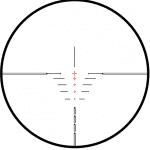
3. Bushnell Trophy TRS-25 Red Dot Sight
Check Price: Amazon
Red Dots are another great option for crossbow hunters. You don’t have to spend a lot of money for a great crossbow red dot. Due to the crossbows short range you can pair it with an affordable micro red dot. Bushnell’s Trophy TRS-25 is a great value for the price.
Bushnell designed its TRS25 red dot to perform way above its price. Bushell really went all out when designing its micro red dot. It’s even marketed towards crossbow hunters. It features an extremely durable design that’s completely shockproof. It was designed to withstand the multi-directional recoil of a crossbow. The sights is nitrogen purged and O-ring sealed for a 100% waterproof and fogproof seal.
Bushnell’s Trophy red dot has an extremely clear and bright sight picture for the price. You can choose between 11 different brightness settings to adjust to the ambient light. The true 1x multi-coated glass lens reduces glare while increasing the perceived brightness. With over 1000 hour battery life you won’t have to worry about changing batteries during your hunt. You could go out every day of the season and still have some remaining charge. The 2 MOA red dot is perfect for hunting at close to medium range. The only thing it’s missing is a range estimation tools.
4. UTG 30mm 36-color Crossbow Scope
Check Price: Amazon
UTG’s 30mm Scope is another great option for your hunting crossbow. UTG (aka leapers) is a well known brand in the European market and only recently moved production into the United States. Their brand is built around high quality yet affordable tactical products.
UTG really threw a ton of features into this affordable scope. Built on a true strength platform that’s entirely shockproof. Completely sealed and nitrogen filled to offer rainproof and fogproof protection. While it isn’t entirely waterproof you shouldn’t have any trouble with heavy downpours. The tool free index ring allows you to adjust point of impact between 275-385fps for excellent precision.
By far the coolest thing about the UTG scope is the illuminated reticle. You can choose between red/green illumination or 36 other custom color comabos. With so many illumination settings you’ll be able to accomodate all weather and lighting conditions. There’s also a sunshade to further control ambient light. The fixed 4x magnification is perfect for all your hunting needs. The reticle was designed specifically for crossbows and offers aiming points between 20 and 50 yards. You aren’t going to find all these features in any other comparably priced scope.
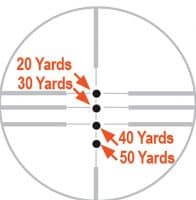
5. TRUGLO Crossbow Scope 4×32 IR
Check Price: Amazon
TRUGLO’s scope is another affordably priced option with a lot of features. Truglo makes a lot of great entry level hunting equipment. All of their products are affordably priced and feature excellent illumination.
As the name implies Truglo is known for their illumination technology. They throw illuminated reticles into almost all of their budget product lineup. With red and green illumination with multiple brightness settings you can dial in your reticle. The reticle features easy to use range estimation lines that cover the span of the sight picture. It’s a little to busy for my taste(especially with the illuminaion), but it is quite functional. The sight picture is clear and bright with its 32mm lens. Its 4x magnification is about the norm in the crossbow market. The only thing I don’t like about this scope is its eye relief. It only has a 4″ eye relief which is a bit short on a crossbow scope.
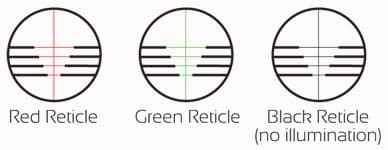
6. Barnett 4x32mm Cross Scope
Check Price: Amazon
The Barnett scope is another affordably priced option that’s well worth a look. Barnett designed this no frills scope to be as tough as it looks. Featuring a no nonsense design that’s built to last.
Barnett really designed this scope to give hunters everything they need in a cheap scope. It’s both extremely durable, water resistant and offers a limited lifetime warranty. Like all the other scopes on this list Barnett included a five point range estimation system in its reticle. The glass is clear and bright with the 32mm objective lens. Built on a compact platform the Barnett scope pairs well with any full sized crossbow. It has a fixed 4x magnification and extended eye relief. For an entry level scope you can’t beat the durability of Barnett.
Crossbow Scope Magnification Power
Crossbow scopes are much like traditional scopes in the way they measure magnifications. Due to their relatively low maximum range the magnification is typically lower than traditional scopes. You’ll most likely see magnification ranges like the following:
- 3x32mm
- 1.5-5x32mm
- 4x30mm
- 4x32mm
Determining the magnification seems complicated, but it’s really not. The first number before the x is the magnification range. If there is only one number before the x than it designates a fixed power scope. When there’s two numbers before the x it is a variable magnification scope. You can adjust the focus throughout the entire magnification range. Personally I like to pair crossbows with a fixed power scope, but the choice is yours. The number after the x represents the objective lens size. That’s the far lens on the end of the scope that lets light in. Typically the larger the lens the brighter the scope is going to be, but there are a lot of other variables that can affect light output. Crossbows don’t have a lot of room so you need to find a relatively compact scope.
Different Reticle Types
There are a ton of different reticles on the market and it would be impossible to talk about all of them. As a general rule you’re going to want to stick to reticles with range estimation tools on a crossbow. After 20 yards you’ll notice a considerable drop in your bolts ballistic properties.The more reference points your reticle has the easier it will be to extend your range. That being said with a little practice you can get accurate with just about any scope even if it doesn’t have range estimation. Many bow hunters like to bring along a range finder to further improve their long range accuracy.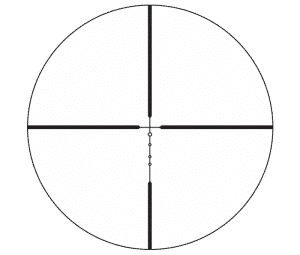
Nikon’s Bolt XR Crossbow Scope can be seen to the right. It gives a really good example of an effective crossbow reticle. Assuming you sight in your scope at 20 yards you’ll be able to effectively estimate your range all the way out to 60 yards. Farther if you learn to use the bold portion of the reticle. Another great thing about this scope is its uncomplicated design. The close shooting range of a crossbow makes uncluttered reticles more effective.
Improving Brightness in Low Light Conditions
As a general rule of thumb the bigger the objective lens the brighter your sight picture. Increasing the scopes aperture size will allow a lot more light to come in. More light will mean better performance in low light conditions. It’s somewhat complicated on the technical side of things, but the further you zoom in the darker the image is going to be due to the decreased aperture size. As you increase the magnification amount you should also increase the objective lens size. Major scope manufacturers have some of the best optical technology in the world and they can’t even improve the brightness on a small lens. Doing a little photography work in the 90’s taught me all about the struggles of aperture size.
Traditional Scope Vs Red Dot
Recently bow hunters have been switching to the newer red dots on the market. The compact size long battery life and extreme durability make red dots a great option. What’s really nice about using a red dot is that they tend to have a much brighter sight picture. Their large sight picture allows you to quickly get on target and easily track game. You’ll be able to easily target using both eyes without having to worry about parallax.
A red dots major disadvantage is that they’re typically a fixed 1x magnification. Unless you choose to go with a Trijicon Acog which costs a small fortune. Trijicon designed their fixed 4x magnification acog specifically for crossbow hunters.If you want to get a red dot you’re going to have to practice a lot more. Without range estimation tools you’ll have to completely guess at bolt drop. However through practice you can learn to properly estimate out past 40 or 50 yards.
Other Things To Consider
There are a lot of components that go into making a good scope. Some manufacturers do a better job than others at improving their product line.
Illumination: You’ve most likely seen advertisements for scopes that come with illuminated reticles. You primarily find illuminated scopes in the high end range of optics. Illuminated reticles will greatly increase the perceived light in even the darkest days. These scopes will have lighted up crosshairs or dots making them much easier to see.
Weight: Weight is one of your primary concerns for mounting a scope to a crossbow. Since you’re primarily looking for a hunting scope the weight needs to be low. The 1lb difference might not seem like much from the comfort of your couch, but it’s huge out in the woods. When you’re carrying a full load of hunting gear every 1lb matters.
Lens Coating: Almost every scope has some form of coating on their lens now a days. With every manufacturer claiming their coatings are the best it’s tough to differentiate the good from the bad. The only way you can really tell is through brand recognition and sight. Try and look for lenses that claim to be fully multi-coated for optimum performance.
Eye Relief: A scopes eye relief measures how far away from your scope you can be to still see a full picture. With a crossbow you are going to want to get the longest eye relief possible. With powerful crossbows you want to get as much room as you can away from the bows recoil. Otherwise you might just go home with a fresh black eye.
Parallax: Parallax is one of those things that you can’t really explain through words alone. When you’re looking through a scope with parallax moving your head from side to side will change where the reticles centered. Most of the time it will only be a few inches left or right, but that could be the difference between a clean kill and a deer left suffering.
Mounting and Adjusting Your Scope
Assuming you have a crossbow made in the last 20 years mounting a scope should be easy. Almost every crossbow nowadays comes from the factory with either a picattiny or weaver rail. Most scopes are going to come with standard mounting hardware, but if you buy an aftermarket scope who knows. To mount your scope you’ll first need to determine the tube diameter. Once you determine the tube diameter purchase the corresponding mounting rings. Simply tighten the scope to your rail using the provided allen wrench.
Once your scope is mounted to the rail you are going to want to sight it in. Make sure you sight in your bow at a indoor range or on a day without a lot of wind. Wind will seriously alter the movement of your bow causing inaccuracy. The easiest way to sight in your scope is using a crossbow rest, but you can also sight it in by hand.

